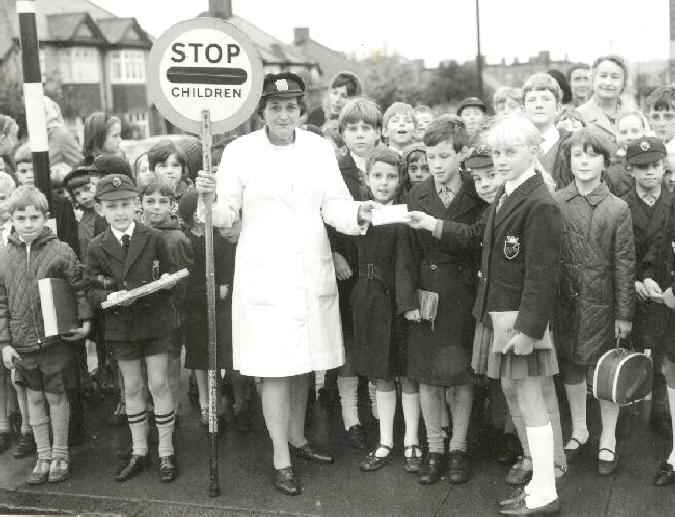
English School Uniform: Coming and Going to School--Lolipop Ladies

Figure 1.--A perennial English education favourite is the "Lollypop Lady". Her role is to enable children to cross busy roads safely on their way to and from school. This photograph looks to have been taken in the late 1960s. Many of these children, especially the boys wearing caps, look to be from a private school.
|
|
A perennial English education favourite is the "Lollypop Lady". Her role is to enable children to cross busy roads safely on their way to and from school. Her job title is derived from the "lollypop" shaped hand-held pole which is used to
help show car drivers where she is in the road. This is a common convention seen all over Britain in the morning and in the afternoon. I am not sure when these lolipop shape poles first appeared. It may have been after World war I when in the 950s it became more common for average families to own cars. Most of the people involved are middle-age ladies living neaer the school. Often the children becomne very attached to the ladies who they seen every day, sometimes for years. Many of these children, especially the boys wearing caps, look to be from a private school (figure 1).
Crossing Guards
A perennial English education favourite is the "Lollypop Lady". Her role is to enable children to cross busy roads safely on their way to and from school. Her job title is derived from the "lollypop" shaped hand-held pole which is used to
help show car drivers where she is in the road. This is a common convention seen all over Britain in the morning and in the afternoon. Most of the people involved are middle-age ladies or retired individuals living near the school.
Chronology
I am not sure when these lolipop shape poles first appeared. It may have been after World war I when in the 950s it became more common for average families to own cars.
Personal Attachments
Often the children becomne very attached to the ladies who they seen every day, sometimes for years. A British reader writes, "I remember all my lollipop ladies (and men for that matter - it wasn't just middle-aged housewives who did
it, but also retired old folks). Sometimes we would stand at the side of the road with them chatting for ages before we'd cross - often letting other kids go and staying over! We used to give them Christmas cards and the like, and chocolates if they retired. They were in a way like teachers or class helpers we could admire and use as a substitute mother-figure whilst out of home as we never saw them long
enough for one party to become bored of the other!"
Rebellion
Some of the children, especially the boys, began to rebell that last year in peimary school. A reader writes, "It became a sign of rebellion to deliberately no longer use the lollipop lady but out of a sense of misplaced independence to cross further down the street. Likewise, when you got past the age of 11 you were seen as being conformist or weak if you used their services."
The Schools
Lolipop ladies helped out at both public and private schools. Many of these children in the photograph seen here, especially the boys wearing caps, look to be from a private school (figure 1).
HBC-SU

Related Chronolgy Pages in the Boys' Historical Web Site
[Main Chronology Page]
[The 1880s]
[The 1930s]
[The 1940s]
[The 1950s]
[The 1960s]
[The 1970s]
[The 1980s]
Related Style Pages in the Boys' Historical Web Site
[Main school uniform page]
[Main country page]
[Long pants suits]
[Short pants suits]
[Socks]
[Eton suits]
[Jacket and trousers]
[Blazer
[School sandals]
Navigate the Boys' Historical Clothing School Uniform Pages
[Main School Uniform Page]
[Australia]
[England]
[France]
[Germany]
[Italy]
[Japan]
[New Zealand]
[Scotland]
[United States]
Navigate the Boys' Historical Clothing Web Page
[Return to the Main English coming and going to school page]
[Introduction]
[Activities]
[Biographies]
[Chronology]
[Clothing styles]
[Countries]
[Bibliographies]
[Contributions]
[FAQs]
[Glossary]
[Satellite sites]
[Tools]
[Boys' Clothing Home]
Created: 7:20 PM 6/24/2004
Last updated: 9:06 PM 6/24/2004




